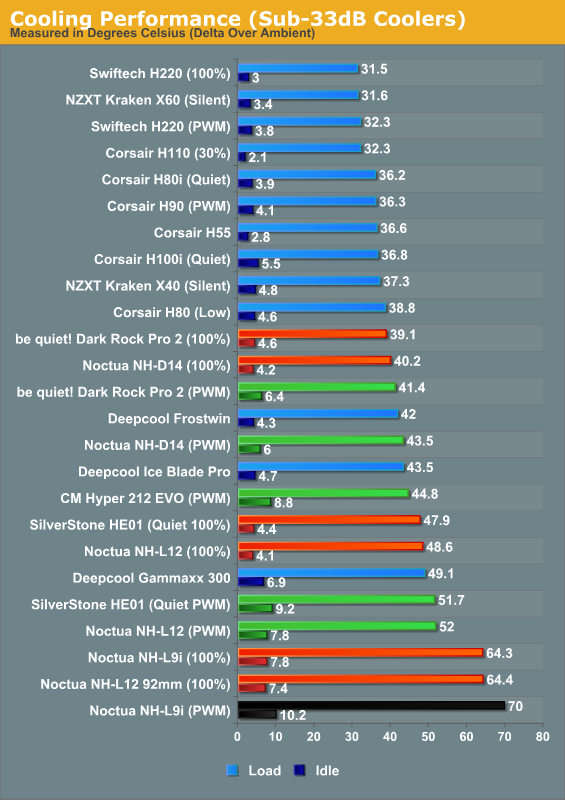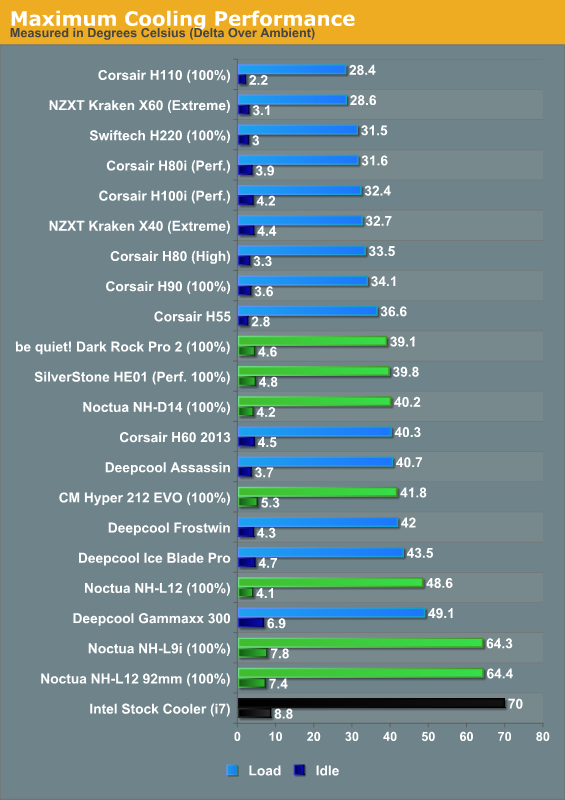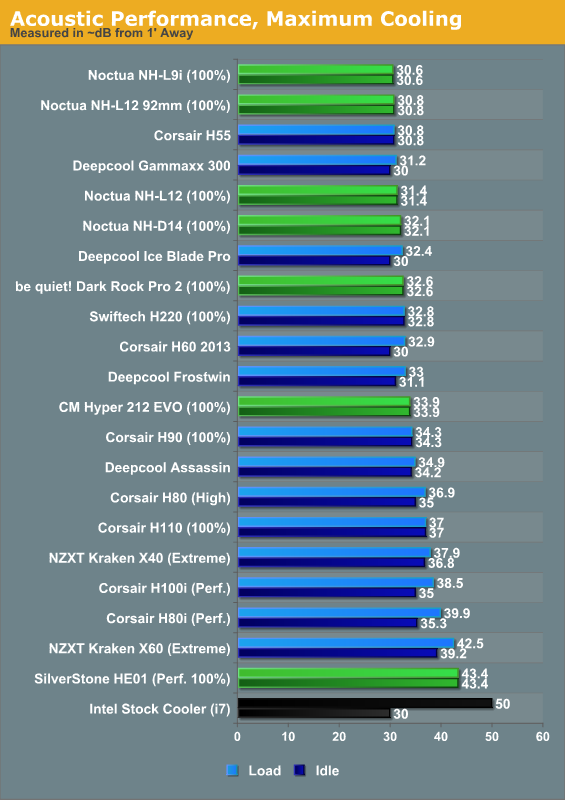CPU Air Cooler Roundup: Six Coolers from Noctua, SilverStone, be quiet!, and Cooler Master
by Dustin Sklavos on March 14, 2013 2:40 AM EST- Posted in
- Cases/Cooling/PSUs
- Cooler Master
- SilverStone
- cooling
- Noctua
- be
Silent Cooling Performance and Absolute Performance
Testing cases is in some ways much simpler than testing coolers, and a large part of that is because outside of an integrated fan controller, there's really not as much variability in the case's stock performance. Coolers, on the other hand, immediately benefit from the motherboard's fan control, and that has to be taken into account. They also have a more direct effect on the CPU's overall thermal performance. That means we need to break down the results into more useful metrics.
The first one is for silent performance. As a noise cap, I've chosen 33dB. Any coolers or settings that resulted in idle or load noise above 33dB have been pruned from the chart.

While every cooler I've tested today makes an appearance on this chart, the closed loop liquid coolers unfortunately have a clear advantage here. These are all quality units using excellent fans, though, and I'm keen to point out that you have to go to a 240mm or 280mm radiator before the closed loop units take a decisive lead. Generally speaking, you can get close to a 120mm or 140mm closed loop's cooling potential in an air cooler with comparable noise levels.
I'm keen to point out that Cooler Master's inexpensive Hyper 212 EVO actually does put in a pretty good showing here. Users on a budget would do well to note that it actually beats SilverStone's much larger Heligon HE01 when the Heligon's fan isn't cranked up.
With silent cooling broken down, let's take a look at the absolute maximum performance that can be gleaned from the coolers we've tested so far.

As it turns out, the closed loop coolers have a bit more headroom left in them compared to the majority of the air coolers tested. Our top performing trio is pretty much neck and neck for thermal performance, and even the Cooler Master Hyper 212 EVO is able to get awfully close to them. If you want high end air performance, you can definitely have it at a good price.

Of our big winners, though, Noctua and be quiet!'s solutions prove to be the quietest. SilverStone's Heligon may be able to produce comparable thermals, but that 38mm thick fan has to do an awful lot of grunt work to get there.










63 Comments
View All Comments
cjs150 - Thursday, March 14, 2013 - link
Personally I would also prefer water cooling for the simple reason that a good (thick) 240/280 Radiator can cool both CPU and GPU and there is no need to worry about whether the RAM heatspreaders are too tall for the air cooler.What the result show is just how good the closed loop water coolers have become.
However, there is no denying air cooling is simpler, less prone to messy accidents (I know!) and perfect for those who like to keep the computer on all the time. Nice review and keep up the good work
James086 - Friday, March 15, 2013 - link
A minor caveat: be sure to point a fan at the ram and motherboard heatsinks. I didn't and because there was no airflow around my motherboard, it popped a VRM.StevoLincolnite - Monday, March 18, 2013 - link
Ram cooling isn't important, they don't even need heatsinks, it's all for looks.However, motherboard cooling is important, spend a little extra and get a motherboard with decent heatsinks or even active cooling like the Sabertooth x79.
Plus, case airflow is important too.
maximumGPU - Thursday, March 14, 2013 - link
Nice review! wish there was a thermalright silver arrow on there to get a more comprehensive look at the high end coolers. When i bought mine it was widely considered superior to closed loops, looking at the review's results i'm not so sure about that now.wiyosaya - Tuesday, April 2, 2013 - link
I've been a fan, pun intended, of Thermalright paired with Scythe fans for a long time. I currently have a TRUE Spirit 120M paired with a very low noise 120mm Scythe fan cooling an i7-3820. The absence of noise was a prime factor for me, and I don't overclock because stability is also of prime concern for me. IMHO, this combination works very well.I, too, would have loved to have seen any of the Thermalright heat sinks in this review.
iTzSnypah - Thursday, March 14, 2013 - link
I don't believe that the case has adequate airflow.iTzSnypah - Thursday, March 14, 2013 - link
Also there is a fault in your testing methodology. When you tested the CLC's you effectively increased the number of case fans, which would increase airflow and decrease load temps.I suggest you retest, with the case always having 3 fans, 1 intake and 2 exhaust.
FragKrag - Thursday, March 14, 2013 - link
I don't think the point here is to get a completely unbiased performance test, but rather test the coolers in a realistic environmentdragosmp - Thursday, March 14, 2013 - link
The thing is there's not more realistic not to have case fans than to have them. One may argue that it's more likely to encounter systems that have one/two exhaust fans than to have only one intake.I'm suspicious of these results as most sites put aircoolers in a much better light and my own experience show it's a bad bad thing to remove rear fans.
In this setup aircloolers spit warm air that is hardly being channeled out by anything; the positive pressure generated by the front intake can be dissipated in many ways that don't move the warm air around the CPU zone. I've worked recently with a 600T, if the up/rear fans were slowed to 400RPM (so still working) with a CM 212+ @1200RPM and a 2700K@4.2GHz the CPU got toasted in games 80°C+ - running the fans @800RPM decreased the temp by some 20°C.
"I removed every case fan but the front intake, which I ran at 5V to prevent it from affecting acoustics while still providing adequate airflow." - how much airflow was there thru the fan-less rear exhausts?
lever_age - Thursday, March 14, 2013 - link
Right, look at how restrictive the back panel looks. Some people with intake-heavy setups (and that would be a whole lot more than a single fan at 5V in a large case that's very far away from the CPU cooler) cut out the spot and use a wire grille instead, and remove slot covers.If it weren't for some of the top venting, the air coolers would have been really suffocated. In that setup, there is a bias towards the CLCs because their fans are actually working close to the actual vents on the case, due to how everything is mounted and positioned.
If you're only testing down to 30 dB, you can easily run a few more decent-quality fans at some ~800 rpm and get some more reasonable airflow without really increasing the noise level measured.